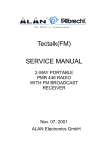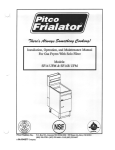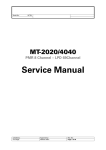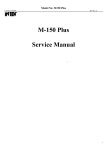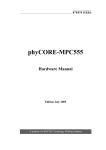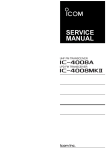Download Albrecht GP 1 Service manual
Transcript
Albrecht GP 1 SERVICE MANUAL GPS + PMR PORTABLE HANDHELD RADIO 24. 04. 2002 ALAN Electronics GmbH CONTENT 1. GPS(Global Positioning System) 2. PMR(Private Mobile Radio) 1. GENERAL 1.1 General 1.2 Characteristic 1.3 Composition 2. SPECIFICATION 2.1 General Specification 2.2 Electrical Specification 3. OPERATION 3.1 Key Name 3.2 ICONS on LCD 3.3 Key Functions 3.4 Setting and Operation 4. ADJUSTMENT 4.1 Frequency synthesizer 4.2 Transmitter 4.3 Transmitter Test 4.4 Receiver 4.5 Receiver Test 4.6 Symptoms, check point & Correction 5. DESCRIPTION OF RADIO CIRCUIT 5.1 Frequency Synthesizer 5.2 Receiver 5.3 Transmitter 3. BLOCK DIAGRAM 4. SCHEMATIC 5. COMPONENT PARTLIST 6. ASSEMBLY DRAWING 7. CHANNEL DATA 1. GPS(Global Positioning System) 1.1 PRODUCTOR : JRC 1.2 MODEL No : ALBRECHT GP 1 1.3 GPS ENGINE SPEC (ATTACH FILE) 2. PMR(Private Mobile Radio) 1. GENERAL 1.1 GENERAL This equipment, ALBRECHT GP 1 is called 2 way portable handheld radios. The frequency range is 446.00625~446.09375MHz UHF operating Channels for international 2 way portable radios. 1.2 CHARACTERISTIC a) All active device in this radio is composed of semiconductor and high density IC. b) To design this radio in compact and weight approximately 273g including battery. C) CPU of this equipment is TMP91CY22F from TOSHIBA. d) It’s power can operate by use of Alcaline 4 cell(1.5V AA) battery. 1.3 COMPOSITION This radio is composed of following. a) Transmitter(W/Antenna) b) Belt clip 2. SPECIFICATION 2.1 GENERAL SPECIFICATIONS a) Frequency Range : 446.00625 ~ 446.09375MHz b) Output Impedance : 50 Ohms unbalanced c) Modulation Type : 8K0F3E d) Communication Mode : Half duplex e) Channel Capacity : 8 Channel f) Channel Spacing : 12.5 KHz g) Power : 6.0V(alkaline) h) Battery Life GPS ON : ALCA 2000mAh > 9hours(Tx 5%, Rx 5%, Stand-by 90%) GPS OFF: ALCA 2000mAh > 16hours(Tx 5%, Rx 5%, Stand-by 90%) i) Operating Temperature : -20 ~ +55 °C j) Dimension : 221.7(H)x 62.8(W)x 40.3(D)mm k) Weight : 280g(with Battery) 2.2 ELECTRICAL SPECIFICATION a) TRANSMITTER 1) Output Power : Max. 500mW 2) Frequency Stability : +/- 3ppm (0°C~ +30°C) +/- 5ppm (-20°C~+55°C) 3) Modulation Method : FM 4) Oscillation Method : PLL SYNTHESIZER 5) Max. Frequency Deviation : < +/- 2.5KHz (with Tone) 6) Cooling Method : air-cooling Method 7) Spurious Emission : < -36dBm/-30dBm 8) FM Hum/Noise : > -40dB(1kHz 60% Modulation, W/CCITT) 9) Distortion : < 5% (1kHz 60% modulation) 10) Tx Audio Response : 6dB /OCT +/-3dB PRE-EMPHASIS (300Hz~2.5kHz) b) RECEIVER 1) Receive Method : Double Super Heterodyne 2) Receive Sensitivity : < 0.28uV(20dB SINAD W/CCITT) 3) Squelch Sensitivity : 6~8dB(20dB SINAD) 4) Bandwidth : > 3kHz(6dB ATT point) 5) Selectivity : < -60dB(12.5kHz) 6) Local Frequency Stability : +/-5ppm(-20°C ~ 60°C) 7) Spurious Response : > 40dB 8) Audio output : 200mW(Internal 8Ohms load THD 10%) EXT 60mW 9) Distortion : < 5% (1kHz 60% Modulation) 10) RX Audio Response : 6dB/OCT +/-3dB DE-EMPHASIS(300Hz~2.5kHz) 11) S/N Ratio : < 40dB(1kHz 60% Modulation W/CCITT) 12) IF : 1’st IF = 21.7MHz 2’nd IF = 450kHz 13) Local Frequency : 1’st Local Frequency = fc – 21.7MHz 2’nd Local Frequency = 21.25MHz 3. OPERATION 3.1 Key Name FUNCTIONS AND CONTROLS 1) Antenna 2) Push-To-Talk (PTT) Button 3) Monitor Button 4) Mark & Power Button 5) External MIC / Speaker 6) Up/Down/Enter Button & Volume Control 7) Page Button 8) Charging Jack 9) Built-in Speaker 10) Built-in Microphone 11) LCD Panel 12) Battery Door Button 3.2 ICONS on LCD 132 * 64 Dots 132 * 64 dots with ICONS 1) TX Indicator Appears when a signal is being transmitted. 2) RSSI (Receiving Signal Strength Indicator) Indicates the receiving signal strength 3) CTCSS Indicator Blinks when the correct CTCSS tone is entered. 4) Seek Scan Indicator Appears in the seek scan mode or when the seek scan mode is activated. 5) Priority Scan Indicator Appears in the priority scan mode or when the priority scan mode is activated. 6) VOX Indicator Blinks in VOX selection mode or appears when VOX is activated. 7) Key Lock Indicator Blinks in auto lock selection mode or when the key lock is activated. 8) GMRS Indicator Appears GMRS is activated. 9) GPS Indicator Appears GPS is activated. 10) Battery Level Indicator Battery Level Meter indicates the remaining battery strength. 3.3 Key Function 3.3-1 Power On/Off & Mark Button(#4) 1) Short Touch a) Under Power off Press this button (#4) briefly to turn the unit on. A short Confirming melody will play. b) Under Power on Press this button (#4) briefly to go Mark Page. 2) Long Touch a) Pressing this button (#4) for more than 1.5 seconds to turn the unit off. 3.3-2 Up/Confirm/Down Button (#6) 1) Up Button a) Short Touch – In the Standby page, press this button briefly to move to the next higher main volume level. – In the Map page, press this button briefly to view a larger area. – In the Pointer page, press this button briefly to cycle through other trip computer information such as average speed, maximum speed, moving direction (heading), bearing, location, elevation, time of sunrise/sunset, trip timer and trip odometer. – In the GPS menu page & Setup page, press this button briefly to shift the current item in each menu to the next item in the same menu. b) Long Touch Pressing this button for more than 1.5 seconds will allow you to navigate at a more rapid rate through different items in the each page. 2) Down Button a) Short Touch - - In the Standby page, press this button briefly to move to the next lower main volume level. In the Map page, press this button briefly to view a smaller area. In the Pointer page, press this button briefly to cycle through other trip computer information such as average speed, maximum speed, moving direction (heading), bearing, location, elevation, time of sunrise/sunset, trip timer and trip odometer. In the GPS menu page & Setup page, press this button briefly to shift the current item in each menu to the previous item in the same menu. b) Long Touch Pressing this button for more than 1.5 seconds will allow you to navigate at a more rapid rate through different items in the each page 3) Confirm Button - In the Standby page, Map Page, & Pointer page, press this button briefly to move to the option selection mode. In the GPS menu page & Setup page, press this button briefly to confirm the required option for respective functions or to go enter the sub-menu. 3.3-3 Page Button(#7) 1) Short Touch In the Standby Page, Map Page, Pointer Page, GPS Menu Page & Setup Page, Press this button briefly to move to the next Page. In the Sub-menu for GPS Menu Page & Setup Page, Press this button briefly to shift from current sub-menu to the higher sub-menus or pages in the each sub-menus. 2) Long Touch - Pressing this button for more than 1.5 seconds will allow you to navigate at a more rapid rate through different pages. 3.3-4. PUSH-TO-TALK (PTT) BUTTON (#2) Press it firmly and speak into the Built-in Microphone (#10) to transmit. Release it to revert to receive mode. 2 Way Call Ringer: Press the PTT button twice quickly to call another party on the same channel and the user selected call ringer melody will play. 3.3-5 MONITOR BUTTON (#3) - Press it to check activity on the current channel before you try to transmit. - Adjust the Volume Control if necessary. - If you press and hold the Monitor button (#3) for more than 3 seconds. - To stop the monitoring press the Monitor Button (#2) and return to the standby mode. 3.3-6 EXTERNAL MIC/SPEAKER (#5) - This jack accepts an optional headset/microphone for totally handsfree operation. Please refer to the enclosed Accessory Order Form to order accessories. See also section regarding VOX SELECTION MODE. 3.4 Setting and Operation 3.4-1 Common function setting 1) Mode setting You can activate the GPS only / PMR only / PMR+GPS / mode. Default mode : PMR+GPS 2) GPS Information Coordinates, Time & Date, Odometer, TTG(Time To Go), Speed, moving direction(Heading), Sunrise/Sunset, Elevation. When you press Up/Confirm/Down Button (#6), GPS position, GPS signal length, GPS status appears in the LCD panel(#11) 3.4-2 GPS function 1) Map Page This feature provides where you are (the animated figure) and provides a real picture of where you are going. As you travel and leaves a trail (track log). Waypoint names and symbols are also shown on the map. 2) Pointer Page This feature helps guide you to a destination. When you are moving with no particular destination in mind, the Pointer Page shows you your moving direction and speed. When you’re moving towards a specific destination, the Pointer page shows you the name of the location, the distance, and time to go. 3) Mark Page This feature provides you to inform or transmit your current position to the another party 3.4-3 PMR function setting 1) Basic channel selection In order to communicate with other PMR units, both you and the receiving party must be on the same channel. ALBRECHT GP 1 has 8 channels for PMR as indicated by the large digits in the LCD Display Panel(#11). Before, trying to transmit on the selected channel, you should press the Monitor Button to check the activity on that channel. If someone is already on the selected channel, you should try another channel that is clear. To change the basic channel, - In the Standby page, press the Up/Confirm/Down Button (#6) briefly to enter to the Basic mode. - When channel is highlighted, press the Up/Confirm/Down Button(#6) briefly to move to the channel selection mode - In the channel selection mode, Press the Up/Confirm/Down Button (#6) briefly to choose an another main channel number. 2) CTCSS (Coded Tone Controlled Squelch System) sub-channel selection mode This feature allows you to utilize a less used channel range (0038) within a main channel. This enables you to communicate with another party on the same main channel using the same sub-code. This helps to avoid congestion on the main channel and filters out unwanted noise and static. There are 38 CTCSS sub-channels for each main channel. To change the CTCSS sub-channel, - When Code is highlighted, press the Up/Confirm/Down button (#6) briefly to move to the Sub-channel selection mode. - In the Standby page, press the button Up/Confirm/Down (#6) briefly to enter to the Basic mode. - The corresponding sub-code will be displayed in the LCD panel (#11). - Press the Up/Confirm/Down button (#6) to confirm your selection. 3) Seek scan mode This feature allows you to scan for an active channel and communicate with the party transmitting. To access the Seek Scan menu, In the Standby page, press the button Up/Confirm/Down (#6) briefly to enter to the Basic mode. Press the Up/Confirm/Down button (#6) to confirm your selection. 4) Priority Scan mode This feature allows you to monitor two different channels at the same time. If you pre-set any priority channel other than the current channel in use, the pre-set channel will be scanned every 0.5 second and signals you when a call is received. To access the Priority Scan mode, When priority scan is highlighted, press the Up/Confirm/Down button (#6) briefly to enter to the Basic mode. To change the Priority channel, In the Priority Scan channel selection mode, press the Up/ Confirm/Down button (#6) briefly to choose the desired Priority Scan channel to use. The corresponding Priority Scan channel will be displayed in the LCD panel (#11). Press the Up/Confirm/Down button (#6) to confirm your selection. 5) VOX selection mode The Voice Activated Transmission (VOX) function allows your voice to activate transmission automatically when the Communicator is used with the optional handsfree MIC/headset (refer to enclosed Accessory Order Form). It also allows handsfree use when a MIC/headset is not being used without having to use the PTT Button (#2). To access the VOX Selection menu, - When VOX is highlighted, press the Up/Confirm/Down button(#6) briefly to move to the VOX response sensitivity selection mode. - In the VOX response sensitivity selection mode, press the Up/ Confirm/Down button (#6) briefly to enter to the Basic mode. The corresponding VOX response sensitivity will be displayed in the LCD panel (#11). - Press the Up/Confirm/Down button (#6) to confirm your selection. 6) VOX recovery time selection mode This allows the response characteristics of the VOX function to be precisely adjusted to suit individual needs. To access the VOX Recovery Time Selection menu, - When VOX Delay is highlighted, press the Page button (#6) until the Radio set up menu appears on the LCD panel (#11) - Press the Up/Confirm/Down button(#6) to select from 5, 3, 2, or 1 second setting. This setting determines the delay time between transmitting and receiving. - Press the Up/Confirm/Down button (#6) to confirm your selection. - Please note you may need to try different VOX time settings to determine the best time to suit your speaking habit. 7) Call Ringer melody selection mode - This feature provides 7 user selectable call ringer melodies to alert you of a calling party. To select your favorite Call Ringer melody, - When Call is highlighted, press the Page button (#6) until the Radio set up menu appears on the LCD panel (#11). And then press the Up/Confirm/Down button (#6) to select your favorite Call Ringer melody. - In the Call ringer melody selection mode, press the Up/Confirm/ Down button (#6) briefly to choose the available to use. - The corresponding Call ringer melody number will be displayed in the LCD panel (#11) and melody will be heard. - Press the ENTER key (#2) to confirm your selection. 8) ROGER SELECTION MODE If Roger option is on, when you finish the transmitting automatically the ALBRECHT GP 1 make a beep sound and transmit a sub-code tone to the partner. To access the Roger Selection Mode : - Press the Page button (#6) until the Radio set up menu appears on the LCD panel (#11). And then press the Up/Confirm/Down button (#6) Roger on or off. - Function Button (#12) from the Key beep selection mode. 4. ADJUSTMENT 4.1 Frequency synthesizer (PLL) a) After connecting the power meter and dummy load (50 Ohms), join the antenna connector of ALBRECHT GP 1 with above equipment. b) Check the voltage between TP & GND in digital volt meter. c) Then set the low channel of ALBRECHT GP 1 the lowest frequency. d) After pressed PTT key of ALBRECHT GP 1, trim VC1 for adjusting the lowest frequency of Tx channel to DC 1.7V in the voltage of TP1. e) After releasing the PTT key, And then check if the highest frequency of Rx channel is within DC 1.0V in the voltage of TP. 4.2 TRANSMITTER a) Connect EUT & measure equipment according to block diagram below. POWER SUPPLY MODULATION METER OSCILLOSCOPE AV VTVM EUT POWER METER DUMMY LOAD DISTORTION METER SPECTRUM ANALYZER ANALYZER AF OSCILLATOR FREQUENCY COUNTER b) Connect DC 6.0V, voltage preset to EUT. c) Connect "power meter" & "dummy load (50 Ohms)". d) Adjust Tx frequency according to trimming trimmer VC2. e) Connect AF oscillator to MIC terminal for conform modulation degree. f) Adjust the frequency of AF oscillator to 1kHz and adjust AF level should be 60mV. g) Checking oscilloscope and modulation meter. max. frequency deviation should be in +/-2.5KHz. 4.3 TRANSMITTER TEST a) Output Power Test Power(6.0V DC) should be Max. 500mW. b) Audio Response Connect AF oscillator to MIC terminal and then firm the audio level that doesn't distortion the wave of oscilloscope in the frequency range, 300Hz~3kHz. Check the audio level for 300Hz~3kHz based on frequency standard, 1kHz. c) Modulation Degree Test 1) Connect AF oscillator to the MIC terminal and then adjust the level to 60mV 2) Measure the oscilloscope wave and he point needle of modulation meter after pressing PTT key. 3) Sweep gradually the frequency of AF oscilloscope from 300Hz to 3kHz. 4) At this time, the point needle of modulation meter should be in +/- 2.5KHz. d) Spectrum Test 1) Antenna is 50 Ohms and attenuator degree should be 20dB more. 2) observe the spectrum with pressing PTT key. The harmonics should be less -36/-30dBm than carrier. 4.4 RECEIVER a) Preparation 1) Adjust the power supply to DC 6.0V 2) Adjust Voltage level to 0.7Vrms(8 Ohms load) after power on. b) Connection method SSG EUT 8 Ohms LOAD OSCILLOSCOPE POWER SUPPLY AV VTVM DISTORTION METER SINAD METER C) The Conform of Rx sensitivity 1) Adjust SSG to channel frequency. 2) Adjust modulation frequency, 1kHz to modulation degree, 1.5KHz. 4) After adjusting the frequency of SSG to channel frequency, RF level sets to -47dBm. d) The Conform of Squelch sensitivity 1) Set the standard channel. 2) In squelch mode, SQ volume RV1 must be turned counterclockwise. 3) After adjusting SSG to channel frequency, the adjusting SSG to level. –120dBm set is audio on, -130dBm set is audio off. 4.5 RECEIVER TEST a) Rx sensitivity test SSG should be adjusted to 12dB of SINAD's point needle seeing wave of oscilloscope as SSG sets in 1kHz with 1.5KHz frequency deviation. At this time, normal RF level is < -119Bm. b) Audio Distortion Test 1) SSG should be adjusted like way of point a) and RF level sets to -47dBm. 2) Adjust to 0.7Vrms(8 Ohms load) seeing Audio wave. 3) Read the needle of distortion meter(normal condition would be less than 5% distortion.) c) Squelch Test After RF level of SSG should be set to the least level, RF level should be gradually increased until speaker makes audio sound. At this point, check RF level (Check Audio on : -120dBm, Audio off : -130dBm) 4.6 Symptoms, Check point & Correction a) Diagnosis method 1) Check each switch to work well. 2) Check voltage of battery. 3) Problem develops from transmitter or receiver? b) Troubleshooting 1) Transmitter Power key is on condition but does not work. Battery could completely discharge. Battery cell twist. Touch problem come between Battery and Radio. Fail to transmit Run out of battery or charge problem. Fault of PTT key. Fault of Q4, Q5, Q6. Transmitter works but frequency is unmatched Out of order in frequency synthesizer. Out of order in X-tal(X2). Audio does not sound(Tx power and Tx frequency are normal) Problem of microphone or MIC connector. IC U7 problem. Tx is set when switch is on. Tx switch problem 2) RECEIVER Rx does not work Speaker line open problem or connector problem. Receiver power circuit problem. Audio amplifier Base band IC U4 problem. Only noise sound U12 problem. VCO problem. Rx sensitivity is weak Antenna mounting problem. Front-End circuit problem. Local oscillation frequency deviation. SF1 saw filter fail. VCO problem. Squelch does not work U12 problem. Control logic problem. 5. DESCRIPTION OF RADIO CIRCUIT 5.1 Frequency synthesizer Frequency synthesizer consists of VCO, PLL IC (built in PRESCALER) and loop filter. a) VCO VCO is composed of ONE VCO. Oscillation circuit takes colpitts circuit using variable Diode. And VCO is composed of D1, Q8, Q9, C81, C75, VC1, L1, C74, C76. VCO control voltage through loop filter adjusts frequency and Microphone signal through Modulation terminal makes modulation. b) PLL IC PLL IC is adjustable IC to produce the wished frequency which VCO provides through loop filter. It has internal counter using 21.25MHz reference frequency to make 6.25kHz as reference Signal. VCO frequency from prescaled input is divided signal is compared with Reference signal phase in phase comparator. Built-in charger pump changes voltage (until two signals are in phase) and charged voltage supplies VCO through loop filter to produce the desired frequency. Frequency data associated with channel goes to PLL IC by CPU through CLOCK, DATA. PLL IC enables by strobe line of CPU. c) Loop Filter Loop filter is composed of R48, R49, C84, C85 and changes pulse from pin14 to DC. and eliminates harmonic component in pulse. It helps VCO oscillate clearly as DC voltage is supplied into Varicap. 5.2 RECEIVER This is composed of Dual Conversion Super Heterodyne. First IF is 21.7MHz. Local oscillator frequency is lower in 1'st IF than Rx frequency. It is called low side injection. Second IF is 450kHz. 2nd local oscillator frequency comes to 21.25MHz. a) Rx/Tx Conversion Circuit Rx signal goes to Rx/Tx conversion circuit through FIXED antenna connector, low pass filter(L5,L6,L7,C42,C43,C46,C47) and receiver resonance circuit composed of L8,C1 When transmitting, voltage through R25,L12,D6 supplies,D7 of receive input is short and Tx is on condition. When PIN diode is off in condition of Rx, L8 and C1 resonate serially and make impedance matching at receiver band pass filter (SF1). b) Front End Front End has Q1 to provide a high sensitivity and low noise feature. It employs Saw filter as band pass filter to eliminate image frequency and to produce enough pass band by Q1 input and output. c) Mixer Mixer has one base BFQ 67W(Q2) to feature high low noise quality. It has RF signal through L7, L8, SF1, SF2 and Q1 RF signal from Local oscillator mixed. It develops 1'st IF 21.7MHz. 1st IF goes to 1st IF amplifier Q3(2SC4083) base through X-tal filter XF1. IF of mixing signals is selected and taken into X-tal filter. Output impedance of mixer is direct matched with input impedance of X-tal filter. Matching of filter satisfies pass bandwidth of filter, ripple elimination with in pass band, and attenuation characteristic of stop band. X-tal filter is composed of two pole monolithic X-tal filter, 8kHz of IF bandwidth R11 is used as impedance matching with 1'st IF Amp Q3. d) IF AMP and Detection 1'st IF AMP Q3 supplies IF(U12) mixer input pin16 through output resistor R13 and C21 to need gain in insertion loss of X-tal filter and last stage circuit. Multi-use IF IC makes up of mixer IF AMP. pin1 2'nd local frequency enter to pin 1. It supplies mixer of internal IC. Mixer output of IC through pin3 passes 450kHz ceramic filter, supplies 2'nd IF amplifier and limits. After 2'nd IF AMP has a process of enough gain and AM rejection, it comes to quadrature detection. Demodulated audio signal by T1 (Quad Coil) is amplified and comes out to pin9. Detected audio signal through R22, VR1 and input in audio amp. IC U4 through C22. e) Squelch Circuit Noise component of detected outputs has amplification Squelch threshold is controlled by Resistor R18,C31,R15 f) Audio Amplifier Demodulated audio signal enters to pin2 of U4. After above signal amplies in U4 pin5 through C220. It comes out to pin5 Then, It reaches at speaker. 5.3 Transmitter When Tx develops with pressing PTT switch, VCO output amplifies through Q4,Q5 transmits by antenna through low pass filter. Tx RF signal produced from Tx VCO is amplified by DRIVER Q5 through C53 and entered Q4 POWER TR input terminal with final amplification. After this stage, the signal is emitted at antenna through 50 Ohms Output matching circuit to low pass filter(L7, L6, L5, C42, C43, C44, C46, C47) to eliminate harmonic. 5.3-1 Audio Modulation and Audio Amplification Audio signal produced by external or internal microphone, limits amplification by IC U7.. It enters to VCO through low pass filter and U2. Max. Frequency modulation deviation is adjusted by VR1 keeps noise and audio from entering to VCO at time of Tx. Audio modulation and Audio Amplification has characteristic of 6dB/OCT pre-emphasis by U7(NJM324V). 3. BLOCK DIAGRAM 4. SCHEMATIC 5. COMPONENT PARTLIST Revised: February 15, 2002 JGP-2002.SCH Bill Of Materials February 21, 2002 Revision: 1.0 17:35:49 Page Item Quantity Reference Part ________________________________________________________________ 1 1 5 6 7 8 5 5 3 14 9 10 1 9 11 12 2 13 13 14 ANT 447 C2,C63,C68,C71,C74 2P C1,C12,C42,C44,C50 4P C3,C16,C48 10P C4,C17,C32,C122,C123, 103 C127,C131,C137,C143,C153, C161,C162,C167,C175 C9 5P C13,C41,C55,C56,C65,C67, 220P C82,C163,C174 C15,C46 6P C19,C21,C23,C24,C31,C45, 102 C52,C64,C92,C112,C149, C154,C172 C20,C29,C89,C91,C93,C94, 100P C95,C111,C126,C128,C157, C401,C402,C403 1 14 37 15 16 1 10 17 18 19 20 21 22 23 24 25 26 27 28 29 30 31 32 33 1 1 1 1 4 2 4 1 3 1 1 1 1 2 1 1 6 34 35 36 37 38 39 40 41 42 43 44 45 46 47 48 49 50 51 52 53 54 55 56 57 58 59 60 61 1 1 2 1 1 1 1 1 1 1 1 3 3 1 1 4 2 3 1 1 1 2 1 1 6 1 1 1 C26,C28,C33,C34,C51,C61, 104 C83,C98,C113,C114,C115, C121,C125,C129,C138,C139, C140,C141,C144,C145,C146, C147,C148,C150,C151,C155, C159,C164,C165,C166,C169, C176,C186,C191,C193,C194, C195 C27 474 C35,C66,C88,C124,C130, 1u C134,C135,C171,C177,C188 C36 22P C37 47P C38 56PU C39 27P C43,C47,C100,C119 7P C49,C62 1P C53,C59,C116,C117 15P C54 12P C69,C72,C75 8PU C73 3P C76 2P2 C78 150P C81 4P3 C84,C156 224 C85 3u3/6T3 C86 223 C101,C102,C103,C104,C108, 22/4T C109 C105 68/6T3 C106 10/16T C107,C196 68/6.3T C110 EECSOH224H C120 220/4E C132 393 C133 820P C152 473 C173 152 CF1 CF450UG CHCN1,CN2,CN3 M2X4 CN101,CN102,CN103 F2X4 CN11 CN16 D1 MA2S372 D3,D4,D6,D7 KDS114 D5,D8 KDS160 D9,D23,D24 KDS122 D11 KDS120 D20 MCL4148 D22 Z02W3.3V D25,D26 S1B D27 KDS121 D28 Z02W10V D41,D42,D43,D44,D45,D46 GRN DEV1 L-SOLDER,X DEV2 H-SOLDER,X E7 XX3P 62 63 64 65 66 67 68 69 70 71 72 73 74 75 76 77 78 79 80 81 82 83 84 85 86 87 88 89 90 91 3 1 1 1 1 2 1 2 5 1 1 1 1 1 2 1 1 1 1 3 1 1 1 5 1 4 1 1 1 8 92 93 94 1 3 34 95 96 5 6 97 98 99 1 2 11 100 101 102 103 4 1 1 23 104 105 3 1 FB1,FB2,FB3 120 GANT 1575 J4 2X1,2mm J22 AT-JY2506 J23 TC-18 L7,L8 24nH L9 22n L10,L41 39n L2,L4,L11,L12,L18 270n L1 10nH L3 47n L5 28n L6 28nH L13 31nH L15,L17 24n L16 8n2 LCD1 64X128 M1 ALBRECHT GP 1 MIC1 OB27P44 OP1,OP2,OP3 S OP4 X,TEST OP5 X P1 COAX CNT Q1,Q2,Q7,Q8,Q10 BFQ67W Q9 2SC4226 Q12,Q13,Q14,Q16 KRA306 Q3 2SC4083 Q4 AT31625 Q5 BFP193 Q23,Q24,Q25,Q26,Q27,Q28, KRC404 Q29,Q34 Q18 KRA304 Q21,Q22,Q33 KTA2015 R2,R5,R15,R19,R22,R24, 10K R28,R30,R31,R32,R34,R41, R42,R44,R52,R118,R119, R121,R122,R124,R126,R128, R129,R131,R132,R133,R135, R142,R144,R146,R152,R156, R159,R161 R7,R20,R106,R107,R177 1K R8,R40,R101,R102,R140, 100 R166 R9 3K3 R13,R148 2K2 R1,R4,R35,R38,R49,R112, 4K7 R113,R115,R141,R157,R158 R3,R11,R46,R54 470 R18 560K R21 5K6 R23,R29,R108,R111,R114, 100K R116,R117,R134,R137,R147, R150,R151,R153,R154,R160, R167,R168,R171,R172,R173, R175,R176,R180 R25,R36,R193 330 R26 1K8 106 107 108 4 2 8 109 110 4 6 111 112 113 114 115 116 117 118 119 120 121 122 123 124 125 126 127 128 129 130 131 132 133 134 135 136 137 138 139 140 141 142 143 144 145 146 3 2 2 1 2 1 1 1 2 1 1 1 1 1 1 1 1 2 1 1 1 1 1 1 1 1 1 1 1 1 1 1 1 1 1 1 TH1,R33,R37,R65 R14,R39 R16,R43,R48,R68,R100, R105,R178,R179 R45,R47,R50,R165 R12,R103,R104,R109,R145, R174 R110,R139,R143 R120,R130 R123,R125 R127 R136,R169 R138 R149 R163 SF1,SF2 SPK1 SW1 SW2 SW3 SW4 SW5 T1 TP10 TP1,TP11 U2 U3 U4 U6 U7 U8 U11 U12 U13 U1 U25 U41 VC1 VC2 X1 X2 X3 XF1 220 22 47K 10 470K 33K 1/0W5 120K 3K9 22K 220K 15K xxx KF446V,KEX 36D08 SLLB12-A-G-B,UP TP1127,PAGE TP1127,PTT TP1127,MON TP1127,PWR T13 TP,PWR ON TP CMX808A R1120N331 NJM386 NJM2072M 324V NJU7016 TB31202FN DBL5018V R1120N361B TMP91FY22F CAT24WC256 UPC2746TB 3PM,TZVY2 10PM,TZVY2 14.7456M 21.25M 4MHz MF21.7M3 6. ASSEMBLY DRAWING 7. CHANNEL DATA CH TX FREQ CH 1’st Local 1 446.00625 1 424.30625 2 446.01875 2 424.31875 3 446.03125 3 424.33125 4 446.04375 4 424.34375 5 446.05625 5 424.35625 6 446.06875 6 424.36875 7 446.08125 7 424.38125 8 446.09375 8 424.39375



































